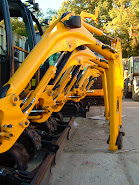If you are involved with moving plant then you are going to spend a fair bit of time on a building site, as a rule you'll invariably be in the way someone will want you out of their way ASAP. Unfortunately this can lead to hurrying and you may find yourself in a dangerous situation, try and work out a methodical way of doing things so that you don't miss something important.
Position
Firstly find somewhere suitable to load / unload, ideally level(ish) and look out for overhead cables and scaffolding. Sometimes you'll end up loading on the road which is far from ideal and can be dangerous.
When I load on the road I will if possible stop with the cab to the oncoming traffic, If you've got beacons, cones or whatever use them, once the ramps are down the lights disappear. Keep your ramps up until you're ready to unload and fold them up as soon as the machine is on or off, then you get the rear lights back and if someone runs into the back of the truck they won't end up on it.
Familiarity
If you've never driven a machine like it before make sure you figure out the basic controls before attempting to load it. You are about to drive a big machine up a narrow ramp on to a 4' high platform, make sure you're happy to do so. If you're not happy about something chances are there will be a machine driver who can advise you or do it for you. Don't be afraid to ask.
Loading
If there's any mud on the machine that will fall off whilst you are travelling, knock it off first whilst the machine is on the ground.
Get lined up properly before trying to climb the ramps, avoid corrections whilst you are climbing them. Don't stop start stop start, take it slow but steady rather than unsettle the machine. Once you are on board you can make minor corrections, get out and have a look if you are unsure. Check the cabguards (if fitted) on the roof are secure and move any magnetic flashing beacons out of harms way.
If you are holding someone up and can pull up outside the site to secure the load do so, you won't get many thanks but you may need a forklift driver another time. Plus you won't end up rushing.
Before Leaving
Take a good look at the load, does it look OK? Could you use another strap or chain? Whilst I don't advocate doing a spiderman job, straps do no good in the toolbox if you are unsure strap it. Do you know your travelling height? Ideally you should measure the machine whilst it's on the ground and add the height of the truck bed plus a few inches margin. Turn your beacons off when you leave.
Friday 14 December 2007
Miscellaneous Plant.
,Rollers
Ranging in size from small pedestrien controlled to great big jobs with enclosed cabs. Twin drum rollers can be basically split into 2 types.

This type is controlled by two levers or tillers similar to track levers, each drum is actually two individual drums allowing one side to turn faster than the other and turn the roller. They can be turned within their own length. The drums tend to clog up with mug quite easily and do not have lots of grip when trying to climb the ramps, clearing out the drums with a bar is one option, but if one is available a winch to help or another machine from site will make things much safer.
These machines usually have a single tie down eye on either end.
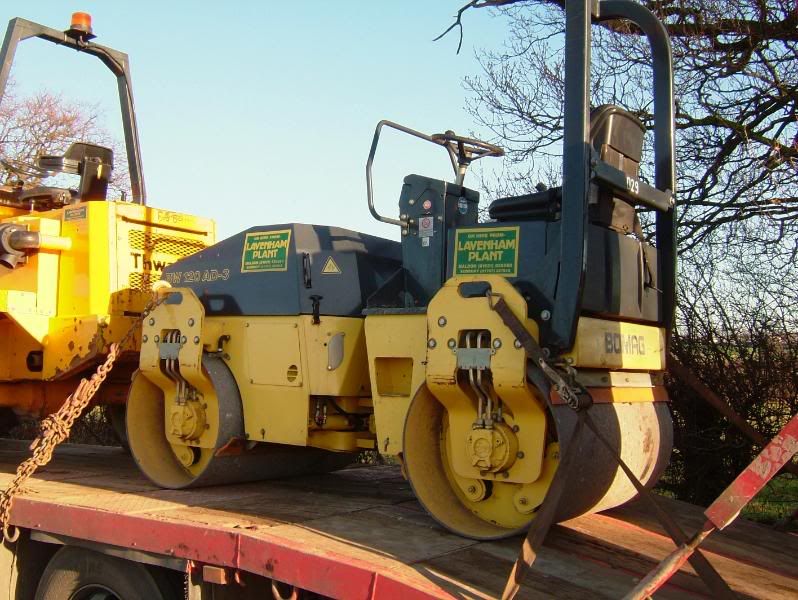
Articulated rollers are generally a bit easier to work with, they steer via a pivot joint like a dumper and are controlled by a steering wheel. There are no pedals however, you set the revs on a hand throttle and push a lever forwards or backwards to control the direction of travel, this is at least progressive so you can still have some control. Smooth drum rollers also require assistance if the ramps are wet or muddy.
These rollers usually have a slot for chains on each corner above the drum as seen below.
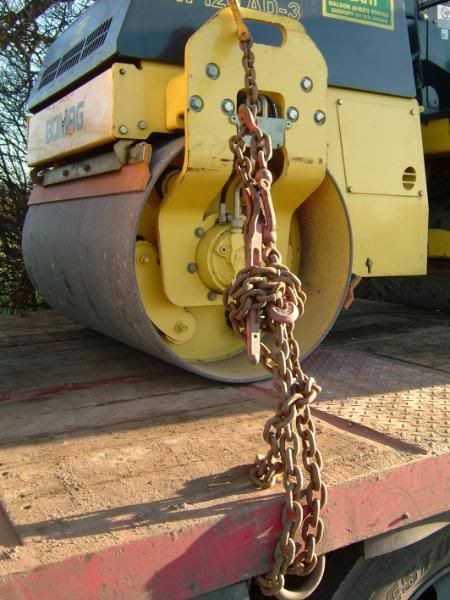
The bigger rollers with cabs are basically a similar principle to control. Tie downs are usually provided on each corner.
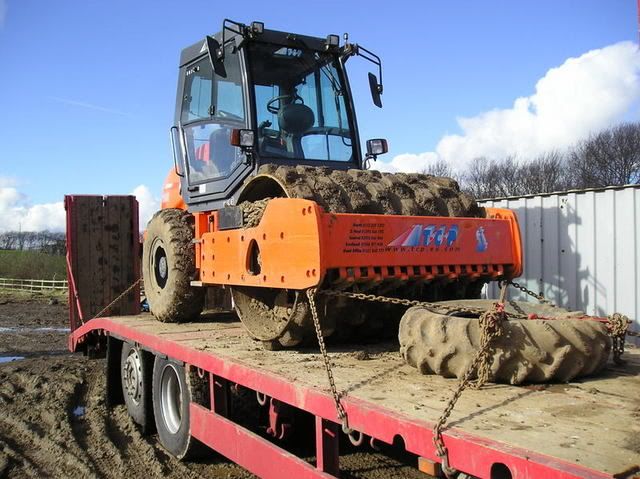
Access Platforms
Typically boom lift or scissor lift. I'm no expert on these so info is a little sketchy.
Scissor lifts

Scissors give a nice flat platform that goes straight up and down. Controlled from the basket. Various sizes from narrow one man units to whacking great machines.
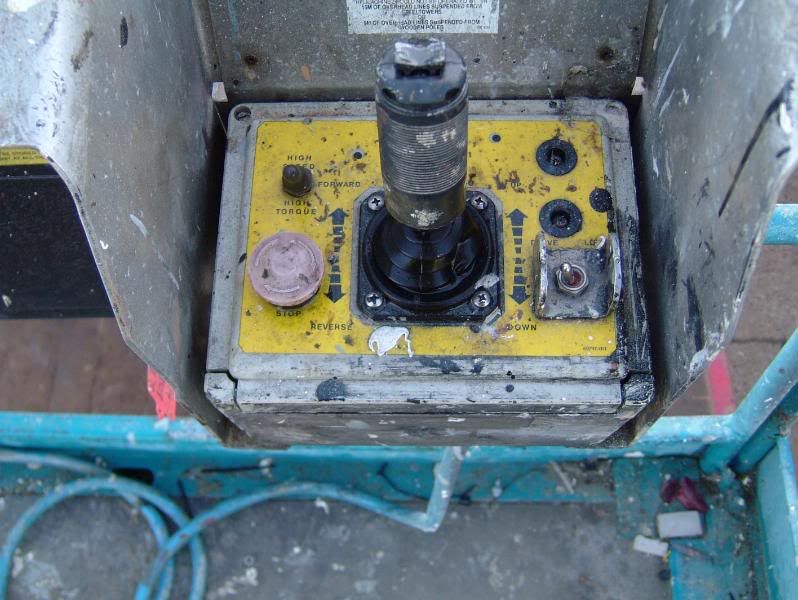
The control box is usually movable and clips on the handrail. Simple controls but requiring careful use. The joystick controls movement forwards and backwards, but is only operative when a deadman switch is also pressed in. Steering is a little rocker switch on the top of the stick, this is where things get tricky. As it is an electric switch it has no feel, so you need to be looking at the wheels to make sure they are aligned correctly, also they do not self centre so they will require the you to steer the opposite direction to straighten up again.
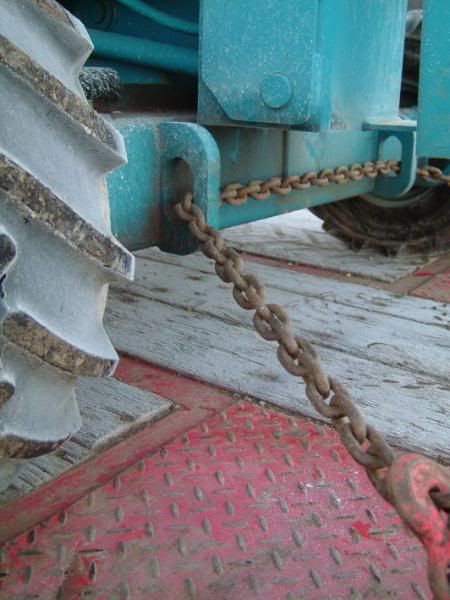

The good news is that they usally have great big tie down eyes on either end.
Boom Lifts
Boom lifts are much more complex as the basket is elevated on a boom, can be tilted and the boom rotates around the chassis. These have two sets of controls, one is on the side of body and can be used to move the platform only (If I recall correctly) There is a switch to pass control to the basket. In the basket there are two joysticks and a deadman pedal which must be pressed to activate the controls. Steering is as per a scissor lift and is quite unusual as you are quite distant from the chassis. The machine will travel much more slowly when the basket is higher than a few feet or slewed round. Again these have tie down eyes on either end.


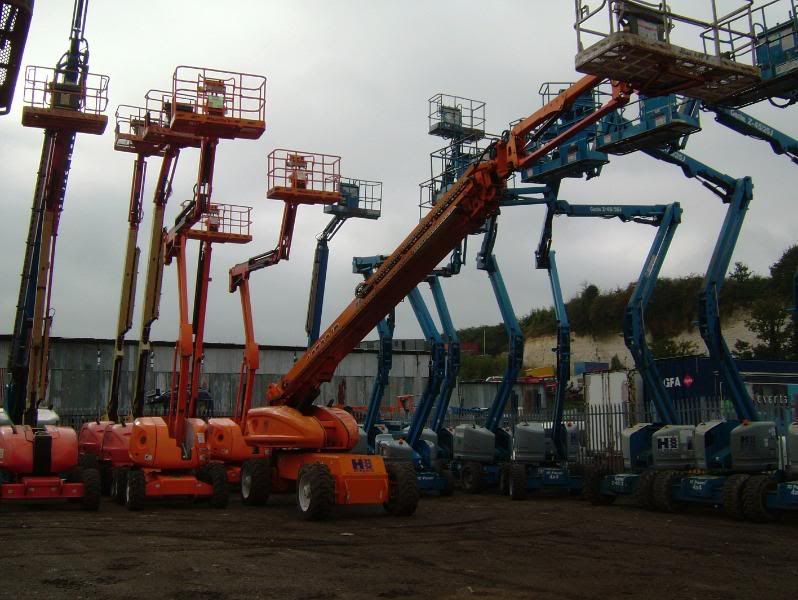
Watch out for the weight of these things, they are much heavier than they look. The weight should be stamped on a plate on the chassis.
Vehicles
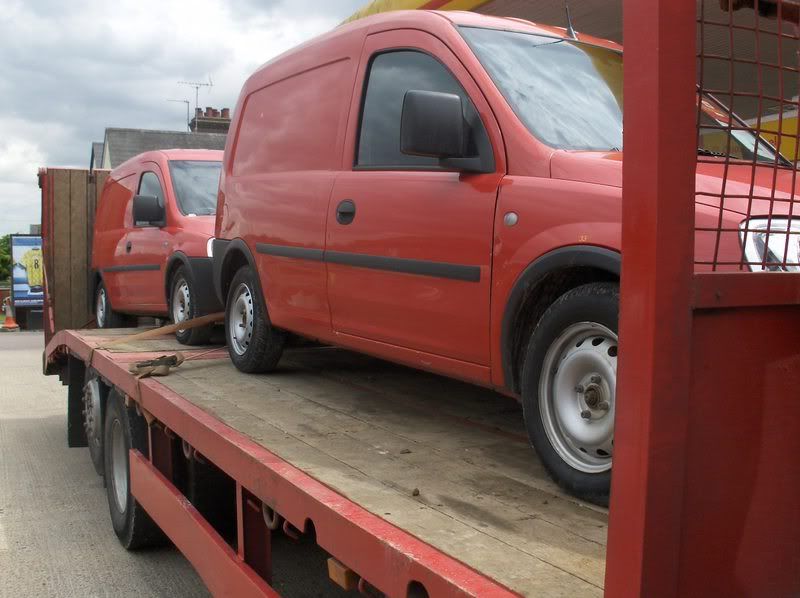
Having a beaver tail and a winch is bound to get you collecting one of the works vans that has broken down, or just collecting and delivering cars and vans at some stage. It's also handy as you can take a van with you when you drop the truck for repairs and you can get home without relying on someone else.

I usually use the front and rear towing eyes to secure vehicles with a single strap on either end, our little pickup hasn't got them however and I strap the hooks through the holes on the steel wheels.
Fuel drums / tanks / IBC's
Approved containers. 45 gallon drums, fuel cubes & flasks or IBC's
Qty. You cannot carry in excess of 1000l of fuel. Also you cannot carry a tank or bowser with a greater capacity than 1000l unless it is empty.
Ranging in size from small pedestrien controlled to great big jobs with enclosed cabs. Twin drum rollers can be basically split into 2 types.

This type is controlled by two levers or tillers similar to track levers, each drum is actually two individual drums allowing one side to turn faster than the other and turn the roller. They can be turned within their own length. The drums tend to clog up with mug quite easily and do not have lots of grip when trying to climb the ramps, clearing out the drums with a bar is one option, but if one is available a winch to help or another machine from site will make things much safer.
These machines usually have a single tie down eye on either end.

Articulated rollers are generally a bit easier to work with, they steer via a pivot joint like a dumper and are controlled by a steering wheel. There are no pedals however, you set the revs on a hand throttle and push a lever forwards or backwards to control the direction of travel, this is at least progressive so you can still have some control. Smooth drum rollers also require assistance if the ramps are wet or muddy.
These rollers usually have a slot for chains on each corner above the drum as seen below.

The bigger rollers with cabs are basically a similar principle to control. Tie downs are usually provided on each corner.

Access Platforms
Typically boom lift or scissor lift. I'm no expert on these so info is a little sketchy.
Scissor lifts

Scissors give a nice flat platform that goes straight up and down. Controlled from the basket. Various sizes from narrow one man units to whacking great machines.

The control box is usually movable and clips on the handrail. Simple controls but requiring careful use. The joystick controls movement forwards and backwards, but is only operative when a deadman switch is also pressed in. Steering is a little rocker switch on the top of the stick, this is where things get tricky. As it is an electric switch it has no feel, so you need to be looking at the wheels to make sure they are aligned correctly, also they do not self centre so they will require the you to steer the opposite direction to straighten up again.


The good news is that they usally have great big tie down eyes on either end.
Boom Lifts
Boom lifts are much more complex as the basket is elevated on a boom, can be tilted and the boom rotates around the chassis. These have two sets of controls, one is on the side of body and can be used to move the platform only (If I recall correctly) There is a switch to pass control to the basket. In the basket there are two joysticks and a deadman pedal which must be pressed to activate the controls. Steering is as per a scissor lift and is quite unusual as you are quite distant from the chassis. The machine will travel much more slowly when the basket is higher than a few feet or slewed round. Again these have tie down eyes on either end.



Watch out for the weight of these things, they are much heavier than they look. The weight should be stamped on a plate on the chassis.
Vehicles

Having a beaver tail and a winch is bound to get you collecting one of the works vans that has broken down, or just collecting and delivering cars and vans at some stage. It's also handy as you can take a van with you when you drop the truck for repairs and you can get home without relying on someone else.

I usually use the front and rear towing eyes to secure vehicles with a single strap on either end, our little pickup hasn't got them however and I strap the hooks through the holes on the steel wheels.
Fuel drums / tanks / IBC's
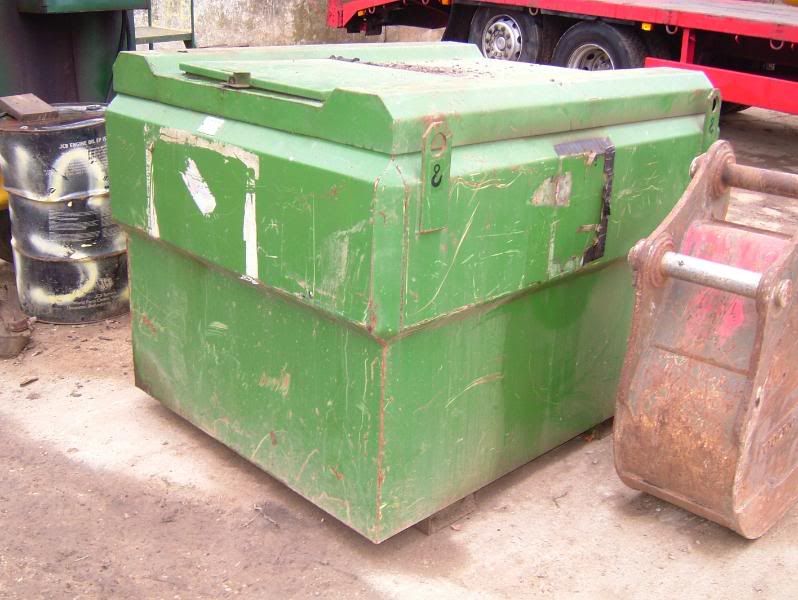
Invariably moving machinery around will find you presented with some fuel to move. Basically you can transport a small amount without ADR as long as you stay within some parameters.
Approved containers. 45 gallon drums, fuel cubes & flasks or IBC's
Qty. You cannot carry in excess of 1000l of fuel. Also you cannot carry a tank or bowser with a greater capacity than 1000l unless it is empty.
Labels:
access platforms,
bomag,
boom lift,
genie,
mewps,
road roller,
roller,
scissor lift
Thursday 13 December 2007
Forklifts
Basically forklift trucks come in all shapes and sizes, but all are either Masted or Telescopic.
Masted Forklifts
Can be anything from a small industrial machine to an offroad 4 wheel drive job. All have a vertical mast with a fork carriage that runs up and down. Smaller industrial machines designed for concrete yards will often need assistance from something else or a winch to get on board. For building sites you'll most likely find a Manitou or a JCB 926 like this one

They are nice easy machines to operate with torque converters and nothing fancy. Generally a chain over the fork carriage at the front and one through the towpin at the back will keep these in place.
I've also had to move a sideloader for a timber yard which is the same principle with the mast to the side.

Telescopics
Telehandler, telesporter, tele or just plain old forks. Rough terrain workhouse of the modern building site anything from a small 2t capacity 4m lift to a 4t capacity 17m lift. Usually with the capability to attach a shovel bucket and can be used as a loader.
Usually these machines are easy to tie down, most have nice big slots to pass a chain through and they are usually clearly marked.


You can also chain down across the towpin, this one is done that way as the machine was new and it damages the paint less.

If there are no suitable tie downs on the front I place a chain over the top of the fork carriage and pull down on that.
One point to watch is that the medium & larger CAT machines are a good bit wider than the JCB or Manitou equivalent. When you load them on you need to have the nearside wheels tight against the side of the body or the offside wheels will be hanging over the edge.

Unlike excavators there is no common system as to how the levers work to control the business end of things. Driving them is straight forward, a simple torque converter gearbox, although I find that sometimes it is best to use 2 wheel steer when I load them on. This is easily switched on the dash. To make sense of raising / extending and tilting the boom it's trial and error really, the bigger machines also have two more levers that control the stabiliser legs.
The smallest machines do not tend to have such good tie down eyes, but they're not so common and can be easily secured with straps.
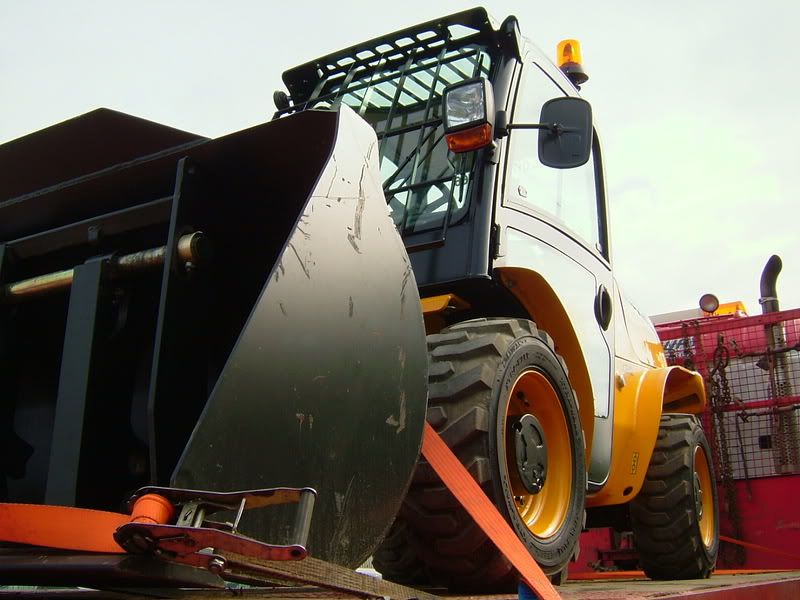
Masted Forklifts
Can be anything from a small industrial machine to an offroad 4 wheel drive job. All have a vertical mast with a fork carriage that runs up and down. Smaller industrial machines designed for concrete yards will often need assistance from something else or a winch to get on board. For building sites you'll most likely find a Manitou or a JCB 926 like this one

They are nice easy machines to operate with torque converters and nothing fancy. Generally a chain over the fork carriage at the front and one through the towpin at the back will keep these in place.
I've also had to move a sideloader for a timber yard which is the same principle with the mast to the side.

Telescopics
Telehandler, telesporter, tele or just plain old forks. Rough terrain workhouse of the modern building site anything from a small 2t capacity 4m lift to a 4t capacity 17m lift. Usually with the capability to attach a shovel bucket and can be used as a loader.
Usually these machines are easy to tie down, most have nice big slots to pass a chain through and they are usually clearly marked.


You can also chain down across the towpin, this one is done that way as the machine was new and it damages the paint less.

If there are no suitable tie downs on the front I place a chain over the top of the fork carriage and pull down on that.
One point to watch is that the medium & larger CAT machines are a good bit wider than the JCB or Manitou equivalent. When you load them on you need to have the nearside wheels tight against the side of the body or the offside wheels will be hanging over the edge.

Unlike excavators there is no common system as to how the levers work to control the business end of things. Driving them is straight forward, a simple torque converter gearbox, although I find that sometimes it is best to use 2 wheel steer when I load them on. This is easily switched on the dash. To make sense of raising / extending and tilting the boom it's trial and error really, the bigger machines also have two more levers that control the stabiliser legs.
The smallest machines do not tend to have such good tie down eyes, but they're not so common and can be easily secured with straps.

Labels:
flt,
forklift,
jcb,
manitou,
materials handler,
telehandler,
teleporter
Tuesday 11 December 2007
Diggers / Excavators
Basically we can break this down fairly simply into two categories, tracked & wheeled.

Tracked machines have the ability to rotate 360 degrees around their tracks, usually referred to as an ?t machine, also known varying as mini / midi - diggers, diggers or 360's. Interchangeable buckets often with quickhitches, can be fitted with hydraulic breakers (peckers / hammers) grapples and grabs.
One key thing to remember is that if you slew through 180 degrees the track levers reverse, for example if the dozer blade is in front you push the track levers forward to move forward. If you rotate the cab so the dozer blade is now behind you and push the levers the chassis will still move forwards but you will be travelling backwards.
The other thing to watch out for is that the left hand control arm tilts out of the way on most machines, some start with it up, some start with it down. When the arm is not locked down the two joysticks and usually the track levers become inactive. On the bigger machines with more space in the cab the arm is fixed, but there is a separate lever that folds up or down to isolate the controls.
The controls in this (cramped) cab give you some idea of what to expect.
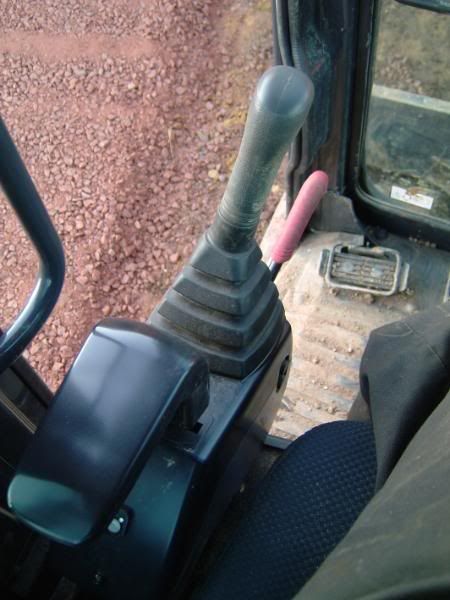 The left hand joystick controls the slew of cab, and the dipper arm in and out. The red lever is the safety lever that must be locked down for the controls to work. On the floor is a foot pedal, which on this machine would operate a hydraulic breaker if fitted.
The left hand joystick controls the slew of cab, and the dipper arm in and out. The red lever is the safety lever that must be locked down for the controls to work. On the floor is a foot pedal, which on this machine would operate a hydraulic breaker if fitted.
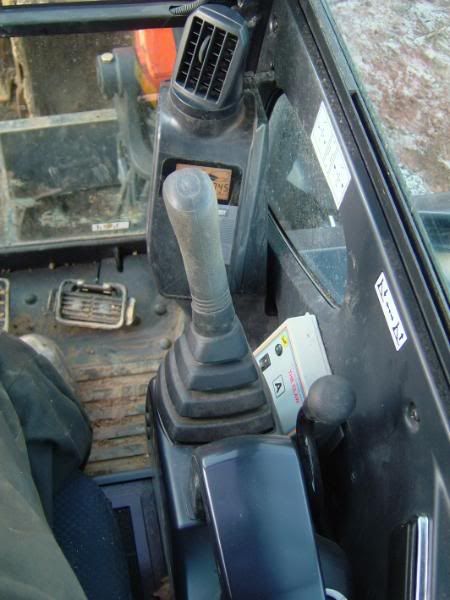 The right hand joystick controls the curl of the bucket (crowding the hitch) and the main jib up and down. The foot pedal would operate the offset boom (see below). The knob next to the armrest raises and lowers the dozer blade and the grey box operates the quick hitch.
The right hand joystick controls the curl of the bucket (crowding the hitch) and the main jib up and down. The foot pedal would operate the offset boom (see below). The knob next to the armrest raises and lowers the dozer blade and the grey box operates the quick hitch.
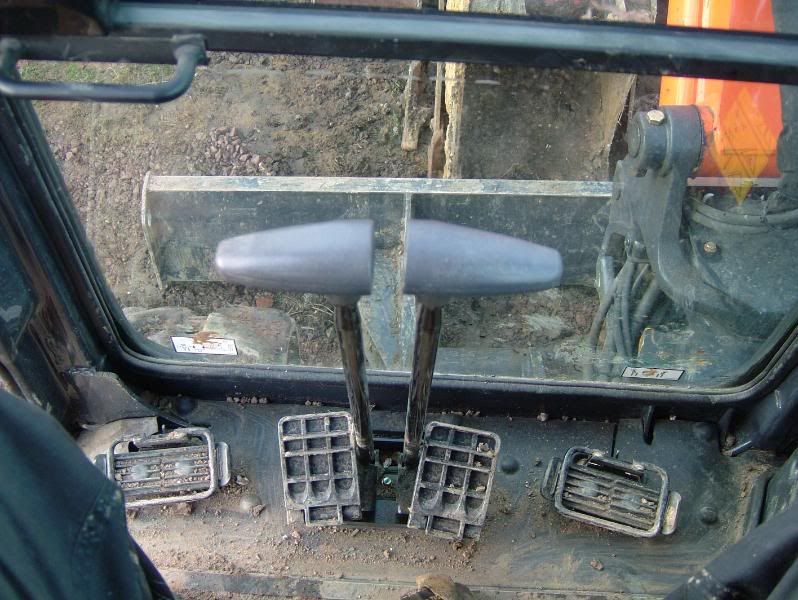 In the middle are the track levers, with fold out foot pedals so you can move it and operate the 2 joysticks. As the machine is now with the blade in front, you would push the levers to move forwards.
In the middle are the track levers, with fold out foot pedals so you can move it and operate the 2 joysticks. As the machine is now with the blade in front, you would push the levers to move forwards.
This is a hydrualic quickhitch it grabs the bucket and can be operated from inside the cab.
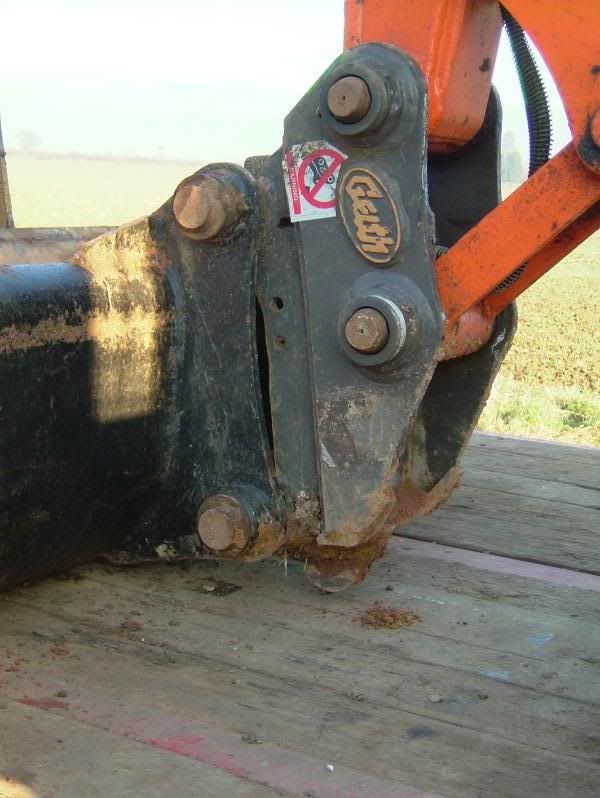
This is the offset boom joint, it allows the boom to work at angles to the cab making it handy to get into awkward places. This can be handy on a zero tail swing machine because you can rotate the cab through 90 degrees to the tracks and fold the boom in and use less floor space on the truck bed.

My final advice on moving diggers / excavators is to watch the weights, they are generally referred to as an 8t machine or whatever. That could actually be a 7.5 or 8.5t weight. This weight can be sometimes found on a stamped factory plate.

but bear in mind that will be the basic machine with no quickhitch or buckets and no fuel either. Realistically it's going to weigh a bit more depending on machine size. If you are unsure of the actual weight it's usually possible to identify the weight bracket the machine comes under by the model number ie. PC27 = 3t Zx50 = 5t / JS 130 = 13t
Just to illustrate this point, the picture below shows two machines loaded, a Hitachi ZX50 on the front and a Yanmar 75 on the back. By the numbers that's 12.5t however once the buckets, quickhitches and fuel are added in they actually weighed 14660Kg. I loaded this at a quarry and noted the GVW on my way out. It was 25960Kg!
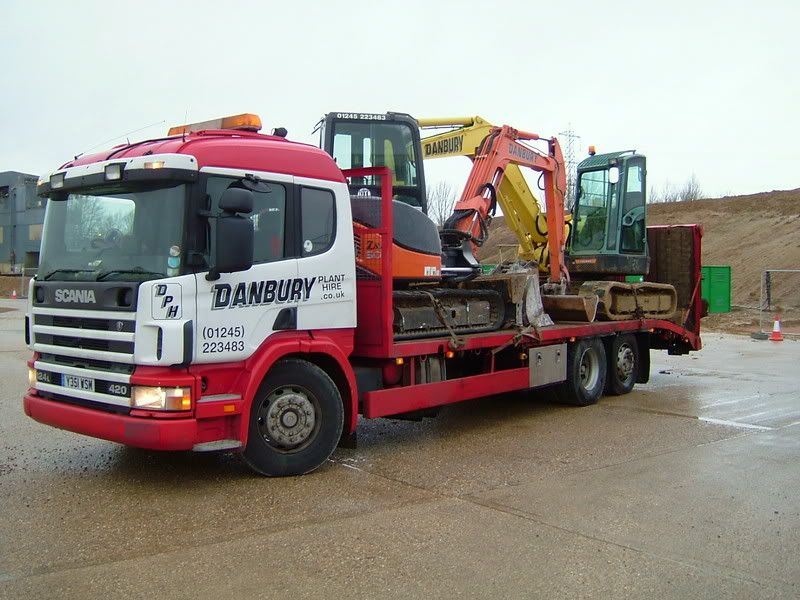

Wheeled diggers, are your stereotypical JCB properly known as a backhoe loader (American terminology) quite simply because the bit that digs is the backhoe and it's got a loader (big scoopy bucket) on the front.
Mini diggers
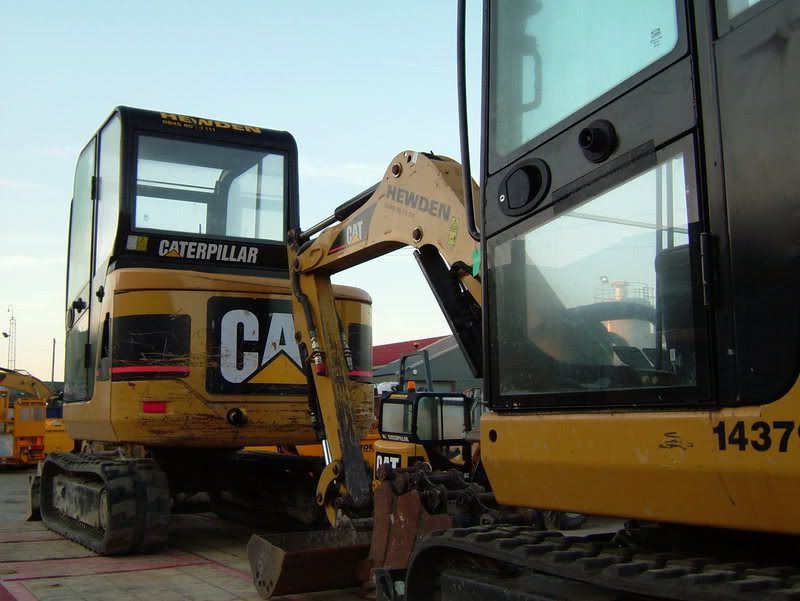
Typically anything 3t or under. Rubber tracks often no full cab some tiny 0.75t & 1t machines have no cab at all just a folding rollbar so they can be taken inside properties. Usually 1.5t is the smallest used, 3t also popular for little jobs like building extensions. Dozer blade on the front. Controlled by two track levers for moving the machine around the site, and two joysticks that control the main boom / jib, dipper arm, tipping link, slewing and occaisionally the offset (more usually a fot pedal). Basically nearly everything that's not on the chassis of the machine. The two joystick control system is fundamentally the same regardless of machine.
Midi Diggers
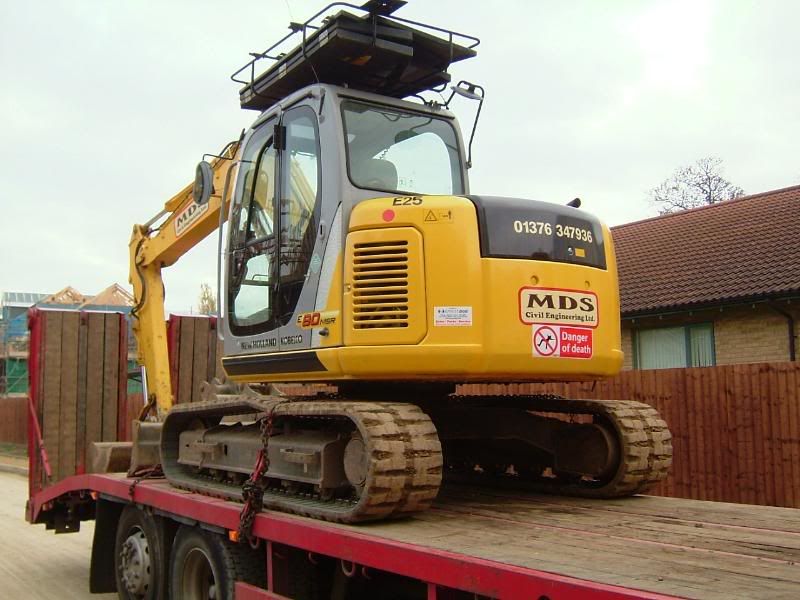
These machines are 5t - 8t in size and are bigger more powerful versions of the above, 5t machines generally on rubber tracks, some 8 tonners running on steel. Often fitted with a quickhitch which allows the buckets to be easily interchanged, hydraulic quickhitches allow the buckets to be changed without leaving the cab. On the bigger cabbed machines there's enough space on the roof to put a rack on to hold cabguards, make sure these are not loose and the lid is secured with something otherwise they fly out. Becoming more popular with Zero or Negative tail swing which means that the arse of the machine does not overhang the tracks when you slew round.
Excavators
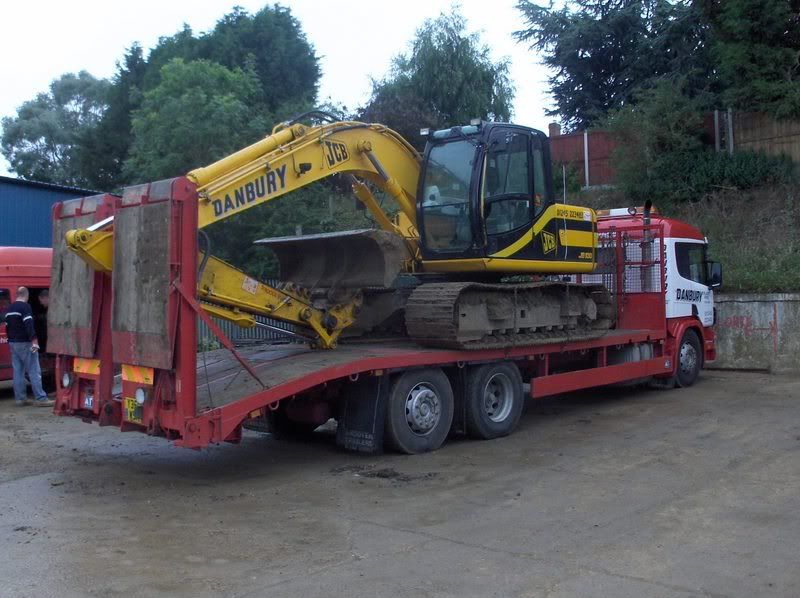
Now getting to the big stuff, same as before just bigger. Steel tracks, but can be fitted with bolt on rubber pads for use on tarmac. 13 / 14 & 20 tonners most common as can be transported on a 44t lowloader. Bigger machines of 30t + will need STGO transport. 20 tonners running at over 11' wide so special rules apply for movements anyway. 13 / 14 tonners can be moved on a rigid although not common. I can just carry this JS130 if it has no buckets on (which is pointless) A slightly 6 wheeler might just manage but generally it'd be an 8 legger to do it.
Ducks

Basically a 360 machine on wheels, usually 13 -18t although a few smaller ones about too. Controls as per normal machines but with a steering wheel and pedals to move around, again the driving controls do not reverse when slewed through 180 degrees, turn left = steer right, to reverse = forward gear. Not too bad until you start shunting one to get in a space and you're the wrong way round. These machines are lowloader jobs as they are tall. Generally used on roadworks as they are a large powerful machine that is manouverable but won't chew the tarmac like a tracked machine.
Wheeled Diggers

Also sometimes referred to as a 180 as the back arm can dig a 180 degree radius. Most common machine is a JCB 3CX although there are Volvo, New Holland and a few others about too. Not as popular as in previous years although still a handy tool. Generally have a set of flips over forks on the front bucket. Taking a 3CX for example it has a nice big cab with a steering wheel and pedals, and torque converter type gearbox. Handbrake and front bucket levers usually found to the right hand side although some better specced machines have joystick controls on the armrests. The seat can be rotated to the rear to control the stabiliser legs and the back arm. These are a bit confusing as the joysticks move in an x rather than a + movement like on a 360. A 4CX like the one above has 4 big wheels and can steer 2 wheels, 4 wheels or crab steer.
These machines are awkward to secure as they generally have poor facilities to tie them down.
Most usually have some tie down eyes at the front underneath the loading bucket arms like this.
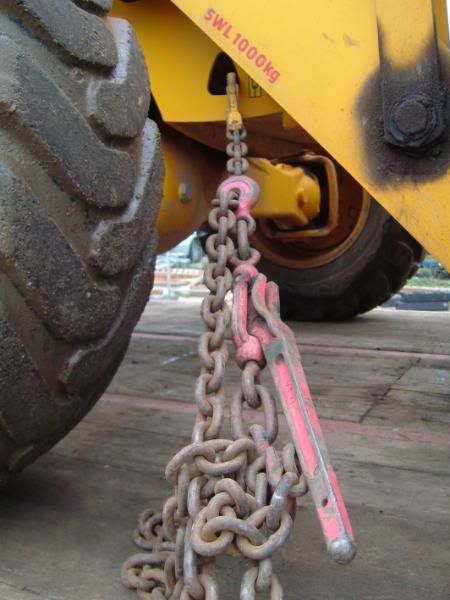
Otherwise I'd either chain across where the bucket meets the arms or strap over the front axles.
At the back they never seem to have tie down eyes (except for Volvo's) On a decent machine I usually pass a chain through the kingpin joint at the back and clamp it down really tight.
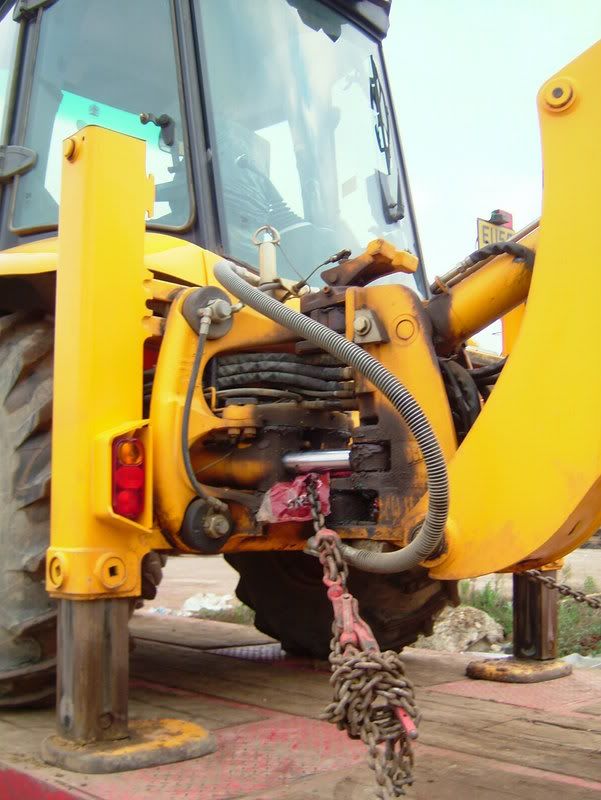
Older machines have a nasty habit of settling on the legs slightly and this will end up with a loose chain, on these I tend to use another chain across the feet and giving a backwards tow. As yet I've never lost one. It's worth checking the straps or chains after a short while if you are unsure,
I never leave the arm raised in the road travel position either as it makes the machine higher than need be, I tend to place the bucket at the foot of the beavertail with the knuckle between the ramps so that it cannot swing out in some freak accident.
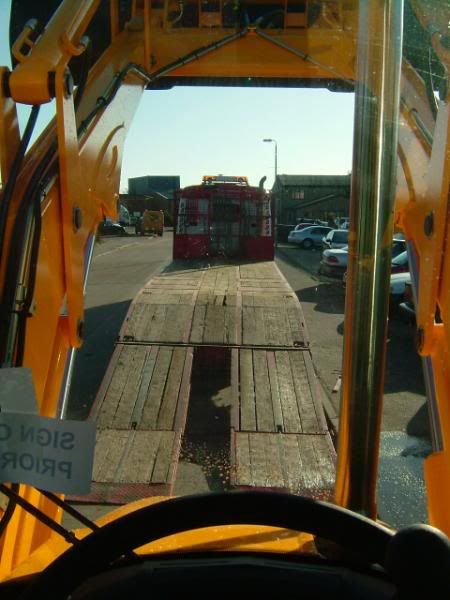
Just a couple of pointers when loading them. Firstly take a look at the brake pedal, it's actually two pedals joined by a little connector. If the catch is open you can brake the left or right side independantly. Make sure that it is shut and the two pedals act as one, as I nearly lost one when I hit the brakes and got it at about a 30 degree angle. I couldn;t work it out until I was told about the split pedal.

Tracked machines have the ability to rotate 360 degrees around their tracks, usually referred to as an ?t machine, also known varying as mini / midi - diggers, diggers or 360's. Interchangeable buckets often with quickhitches, can be fitted with hydraulic breakers (peckers / hammers) grapples and grabs.
One key thing to remember is that if you slew through 180 degrees the track levers reverse, for example if the dozer blade is in front you push the track levers forward to move forward. If you rotate the cab so the dozer blade is now behind you and push the levers the chassis will still move forwards but you will be travelling backwards.
The other thing to watch out for is that the left hand control arm tilts out of the way on most machines, some start with it up, some start with it down. When the arm is not locked down the two joysticks and usually the track levers become inactive. On the bigger machines with more space in the cab the arm is fixed, but there is a separate lever that folds up or down to isolate the controls.
The controls in this (cramped) cab give you some idea of what to expect.
 The left hand joystick controls the slew of cab, and the dipper arm in and out. The red lever is the safety lever that must be locked down for the controls to work. On the floor is a foot pedal, which on this machine would operate a hydraulic breaker if fitted.
The left hand joystick controls the slew of cab, and the dipper arm in and out. The red lever is the safety lever that must be locked down for the controls to work. On the floor is a foot pedal, which on this machine would operate a hydraulic breaker if fitted. The right hand joystick controls the curl of the bucket (crowding the hitch) and the main jib up and down. The foot pedal would operate the offset boom (see below). The knob next to the armrest raises and lowers the dozer blade and the grey box operates the quick hitch.
The right hand joystick controls the curl of the bucket (crowding the hitch) and the main jib up and down. The foot pedal would operate the offset boom (see below). The knob next to the armrest raises and lowers the dozer blade and the grey box operates the quick hitch. In the middle are the track levers, with fold out foot pedals so you can move it and operate the 2 joysticks. As the machine is now with the blade in front, you would push the levers to move forwards.
In the middle are the track levers, with fold out foot pedals so you can move it and operate the 2 joysticks. As the machine is now with the blade in front, you would push the levers to move forwards.This is a hydrualic quickhitch it grabs the bucket and can be operated from inside the cab.

This is the offset boom joint, it allows the boom to work at angles to the cab making it handy to get into awkward places. This can be handy on a zero tail swing machine because you can rotate the cab through 90 degrees to the tracks and fold the boom in and use less floor space on the truck bed.

My final advice on moving diggers / excavators is to watch the weights, they are generally referred to as an 8t machine or whatever. That could actually be a 7.5 or 8.5t weight. This weight can be sometimes found on a stamped factory plate.

but bear in mind that will be the basic machine with no quickhitch or buckets and no fuel either. Realistically it's going to weigh a bit more depending on machine size. If you are unsure of the actual weight it's usually possible to identify the weight bracket the machine comes under by the model number ie. PC27 = 3t Zx50 = 5t / JS 130 = 13t
Just to illustrate this point, the picture below shows two machines loaded, a Hitachi ZX50 on the front and a Yanmar 75 on the back. By the numbers that's 12.5t however once the buckets, quickhitches and fuel are added in they actually weighed 14660Kg. I loaded this at a quarry and noted the GVW on my way out. It was 25960Kg!


Wheeled diggers, are your stereotypical JCB properly known as a backhoe loader (American terminology) quite simply because the bit that digs is the backhoe and it's got a loader (big scoopy bucket) on the front.
Mini diggers

Typically anything 3t or under. Rubber tracks often no full cab some tiny 0.75t & 1t machines have no cab at all just a folding rollbar so they can be taken inside properties. Usually 1.5t is the smallest used, 3t also popular for little jobs like building extensions. Dozer blade on the front. Controlled by two track levers for moving the machine around the site, and two joysticks that control the main boom / jib, dipper arm, tipping link, slewing and occaisionally the offset (more usually a fot pedal). Basically nearly everything that's not on the chassis of the machine. The two joystick control system is fundamentally the same regardless of machine.
Midi Diggers

These machines are 5t - 8t in size and are bigger more powerful versions of the above, 5t machines generally on rubber tracks, some 8 tonners running on steel. Often fitted with a quickhitch which allows the buckets to be easily interchanged, hydraulic quickhitches allow the buckets to be changed without leaving the cab. On the bigger cabbed machines there's enough space on the roof to put a rack on to hold cabguards, make sure these are not loose and the lid is secured with something otherwise they fly out. Becoming more popular with Zero or Negative tail swing which means that the arse of the machine does not overhang the tracks when you slew round.
Excavators

Now getting to the big stuff, same as before just bigger. Steel tracks, but can be fitted with bolt on rubber pads for use on tarmac. 13 / 14 & 20 tonners most common as can be transported on a 44t lowloader. Bigger machines of 30t + will need STGO transport. 20 tonners running at over 11' wide so special rules apply for movements anyway. 13 / 14 tonners can be moved on a rigid although not common. I can just carry this JS130 if it has no buckets on (which is pointless) A slightly 6 wheeler might just manage but generally it'd be an 8 legger to do it.
Ducks

Basically a 360 machine on wheels, usually 13 -18t although a few smaller ones about too. Controls as per normal machines but with a steering wheel and pedals to move around, again the driving controls do not reverse when slewed through 180 degrees, turn left = steer right, to reverse = forward gear. Not too bad until you start shunting one to get in a space and you're the wrong way round. These machines are lowloader jobs as they are tall. Generally used on roadworks as they are a large powerful machine that is manouverable but won't chew the tarmac like a tracked machine.
Wheeled Diggers

Also sometimes referred to as a 180 as the back arm can dig a 180 degree radius. Most common machine is a JCB 3CX although there are Volvo, New Holland and a few others about too. Not as popular as in previous years although still a handy tool. Generally have a set of flips over forks on the front bucket. Taking a 3CX for example it has a nice big cab with a steering wheel and pedals, and torque converter type gearbox. Handbrake and front bucket levers usually found to the right hand side although some better specced machines have joystick controls on the armrests. The seat can be rotated to the rear to control the stabiliser legs and the back arm. These are a bit confusing as the joysticks move in an x rather than a + movement like on a 360. A 4CX like the one above has 4 big wheels and can steer 2 wheels, 4 wheels or crab steer.
These machines are awkward to secure as they generally have poor facilities to tie them down.
Most usually have some tie down eyes at the front underneath the loading bucket arms like this.

Otherwise I'd either chain across where the bucket meets the arms or strap over the front axles.
At the back they never seem to have tie down eyes (except for Volvo's) On a decent machine I usually pass a chain through the kingpin joint at the back and clamp it down really tight.

Older machines have a nasty habit of settling on the legs slightly and this will end up with a loose chain, on these I tend to use another chain across the feet and giving a backwards tow. As yet I've never lost one. It's worth checking the straps or chains after a short while if you are unsure,
I never leave the arm raised in the road travel position either as it makes the machine higher than need be, I tend to place the bucket at the foot of the beavertail with the knuckle between the ramps so that it cannot swing out in some freak accident.

Just a couple of pointers when loading them. Firstly take a look at the brake pedal, it's actually two pedals joined by a little connector. If the catch is open you can brake the left or right side independantly. Make sure that it is shut and the two pedals act as one, as I nearly lost one when I hit the brakes and got it at about a 30 degree angle. I couldn;t work it out until I was told about the split pedal.
Labels:
360,
3cx,
4cx,
backhoe,
digger,
excavator,
hitachi,
jcb,
kobelco,
komatsu,
mini digger,
quickhitch,
wheeled digger,
yanmar
Dumpers
Dumpers come in all shapes and sizes from about 1t capacity up to about 10t for forward tipping machines. They also sometimes have a swivel skip which allows the load to be tipped to either side. They are artic steer, basically the two halves are hinged in the middle and the steering wheel activates a hydraulic ram. Dumpers are about the single most abused piece of plant on the building site. Four wheel drive.
Skiploaders.

These little machines are approx 1t capacity and are very narrow, two can usually be loaded side by side. They are automatic and usually hydraulic drive. One pedal on the floor, press down to go, lift to stop. Usually no handbrake either. Unladen weight is approx 1.5 - 2t
 This is a brand new 3 tonner. It'll never look like this again.
This is a brand new 3 tonner. It'll never look like this again.
2t / 3t / 4t Dumpers.
Usually with a 3 speed manual gearbox and single reverse gear. Three pedals as per car but with vicious clutch, can easily lift the front wheels off the ground when empty if clutch raised too quickly. Unladen weight approx 2.5 -3t

5t / 6t/ 7t Dumpers
Usually with 3 pedals and 4 gears but with a torque converter so 4 forward / reverse gears. Otherwise as 3t dumpers but bigger chassis & skip. Unladen weight about 4.5t

9t / 10t Dumpers
Not that common, bigger version of a 6t dumper. Unladen approx 5.5t
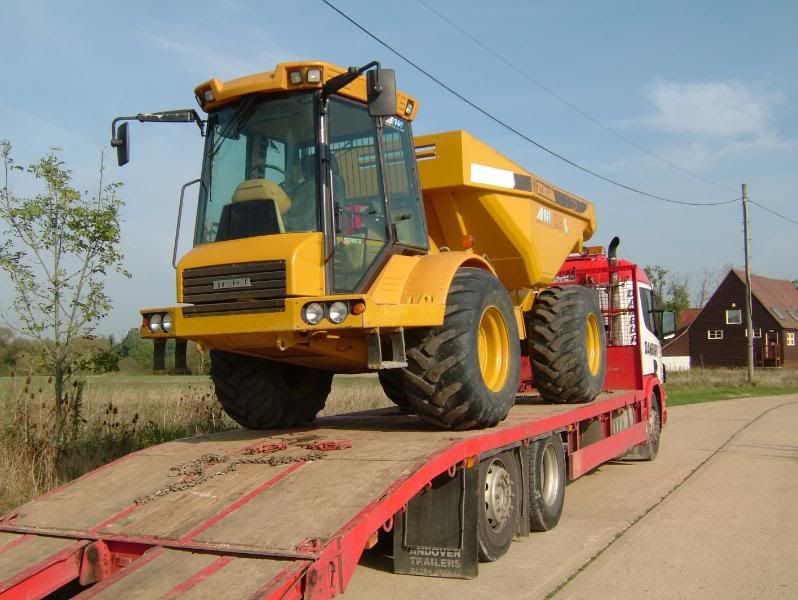
Rear Tipping Dumpers
Hydrema & JCB most common of these, but again fairly rare. Full cab. Torque converter. Capacity 10-12t Unladen weight approx 8t. Really poor rearwards visibility means usually fitted with a rear view camera. Not very common. Bigger versions such as Volvo's, Terex & Bell 6 wheelers are out of my league and need transporting by lowloader.
Loading & Securing them.
Generally where they end up depends on what else is travelling with them, I usually back them on so it is easier to line them up. The smaller ones are light enough to sit up front if they are on their own and not overload the front axle.
I generally use 1 single chain over the centre swivel joint and clamp down tight if the dumper is in good condition with working brakes.
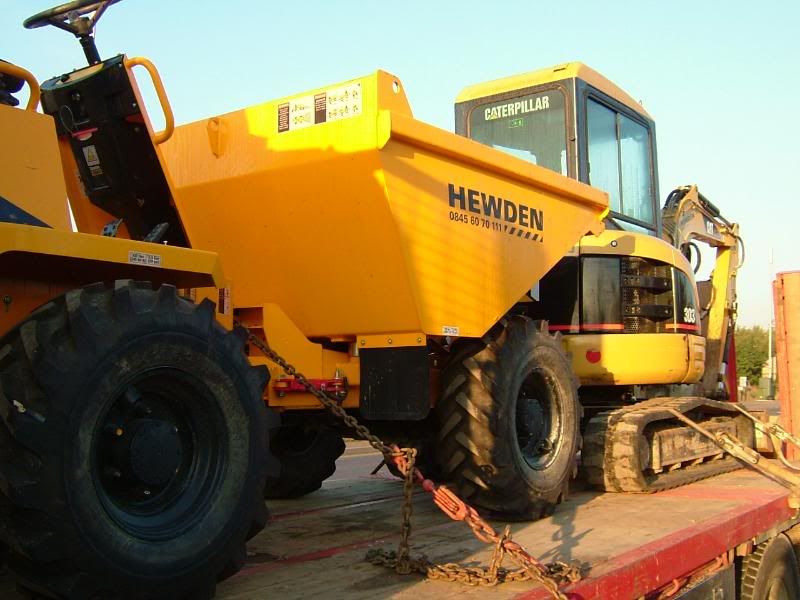
However if they are really knackered and the brakes are iffy I generally use two chains and use the front tie down eyes and the towpin. I carry a spare pin in the toolbox as these are invariably missing or a piece of bent rebar. This is the 'proper' way to secure them.

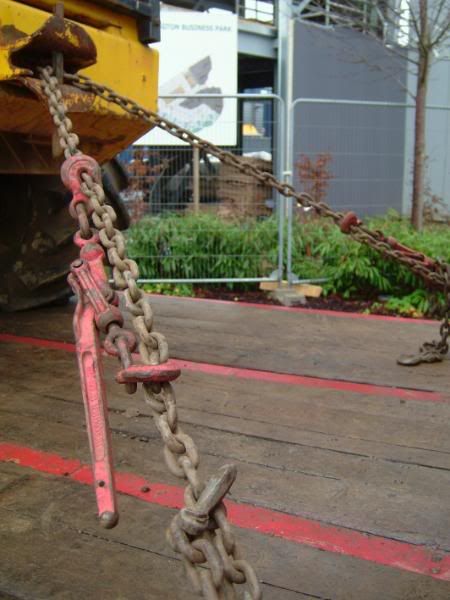
A final note on these is that they do not all have folding rollbars, they can stand very high when loaded so it's worth measuring to make sure of your height. And watch out for the beacon as they often get smashed. Skiploaders often have a beacon that has a bayonet fitting allowing it to be removed and stored under the seat.
Skiploaders.

These little machines are approx 1t capacity and are very narrow, two can usually be loaded side by side. They are automatic and usually hydraulic drive. One pedal on the floor, press down to go, lift to stop. Usually no handbrake either. Unladen weight is approx 1.5 - 2t
 This is a brand new 3 tonner. It'll never look like this again.
This is a brand new 3 tonner. It'll never look like this again.2t / 3t / 4t Dumpers.
Usually with a 3 speed manual gearbox and single reverse gear. Three pedals as per car but with vicious clutch, can easily lift the front wheels off the ground when empty if clutch raised too quickly. Unladen weight approx 2.5 -3t

5t / 6t/ 7t Dumpers
Usually with 3 pedals and 4 gears but with a torque converter so 4 forward / reverse gears. Otherwise as 3t dumpers but bigger chassis & skip. Unladen weight about 4.5t

9t / 10t Dumpers
Not that common, bigger version of a 6t dumper. Unladen approx 5.5t

Rear Tipping Dumpers
Hydrema & JCB most common of these, but again fairly rare. Full cab. Torque converter. Capacity 10-12t Unladen weight approx 8t. Really poor rearwards visibility means usually fitted with a rear view camera. Not very common. Bigger versions such as Volvo's, Terex & Bell 6 wheelers are out of my league and need transporting by lowloader.
Loading & Securing them.
Generally where they end up depends on what else is travelling with them, I usually back them on so it is easier to line them up. The smaller ones are light enough to sit up front if they are on their own and not overload the front axle.
I generally use 1 single chain over the centre swivel joint and clamp down tight if the dumper is in good condition with working brakes.

However if they are really knackered and the brakes are iffy I generally use two chains and use the front tie down eyes and the towpin. I carry a spare pin in the toolbox as these are invariably missing or a piece of bent rebar. This is the 'proper' way to secure them.


A final note on these is that they do not all have folding rollbars, they can stand very high when loaded so it's worth measuring to make sure of your height. And watch out for the beacon as they often get smashed. Skiploaders often have a beacon that has a bayonet fitting allowing it to be removed and stored under the seat.
Labels:
barford,
dump truck,
dumper,
lifton,
neuson,
skip loader,
terex,
thwaites
Chains & Stuff
I'll try and give some advice about the way I secure the plant that I carry, please note that this is the way that I have found works for me as a result of trail and error. It may not be the recommended way but hopefully it might be useful information.
Equipment.
There's a fair bit of kit involved in my job, a lot of it is common in other jobs but I'll describe it and it's uses.
Chains.
Probably the biggest range of kit that I carry, different chains for different jobs detailed below.
Drop Chain.
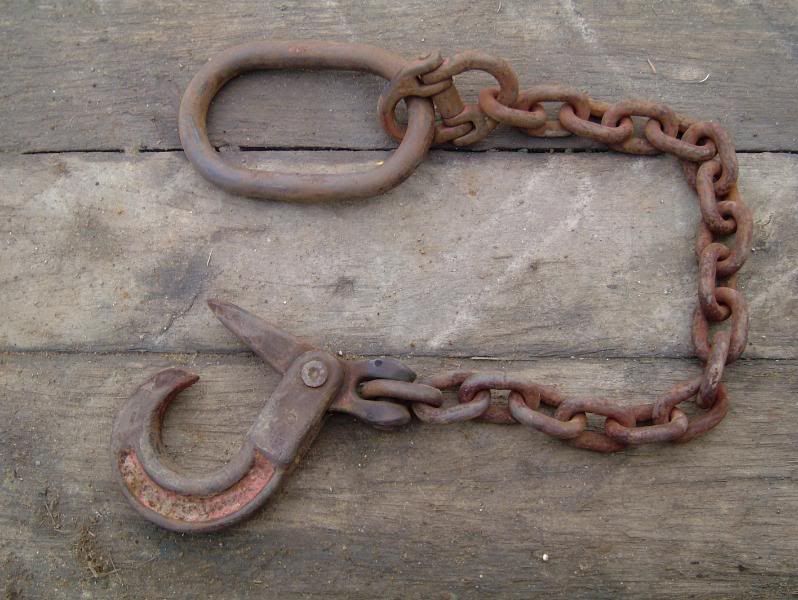
A simple short chain, generally used with a shackle through the lifting eye on a digger. Hook can be looped through sling eyes or bucket pin and back onto ring. Fitted with a large oval ring so can be used on a forklift, although this is not ideal.
Lifting Chains.
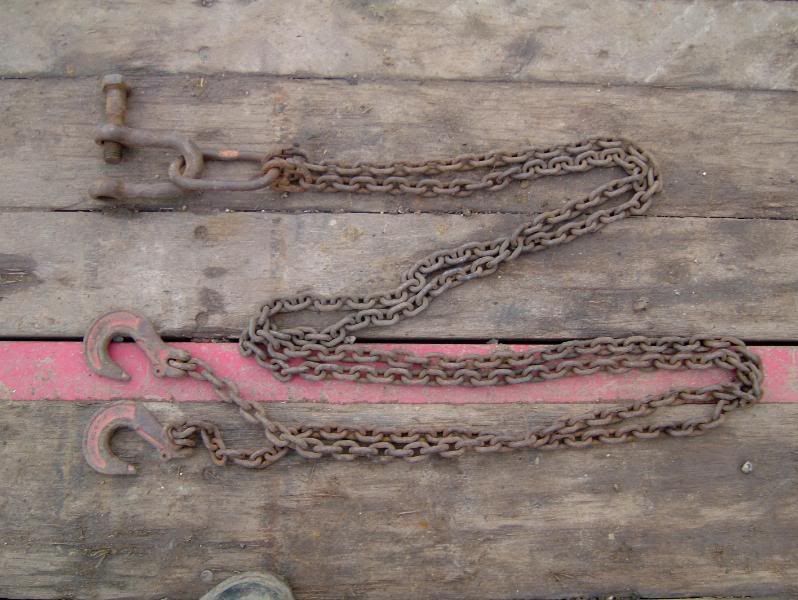
A set of 2, or pair of brothers. Also found in 4's but more usually associated with a crane or HIAB.

As per drop chain used with shackle or on forks, usually used for lifting several buckets or diesel tanks / drums. This set has sling hooks which are missing the safety clips.
Securing Chains - Sling Hooks
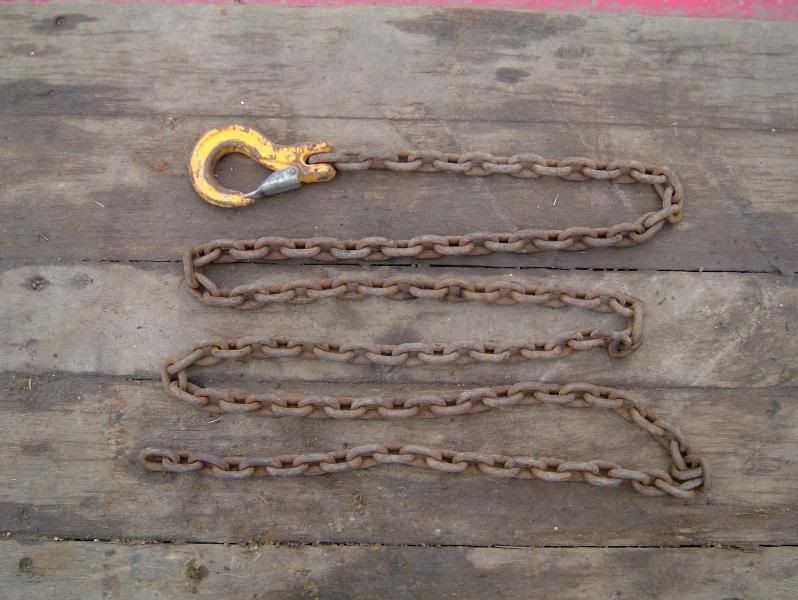
I carry a couple of these chains with large sling hooks on one end only for securing plant with smaller chain eyes. The hook is hooked onto the eye and the tail of the chain is run through a D ring and back towards the hook. A chain tensioner can then be used to pull it tight.
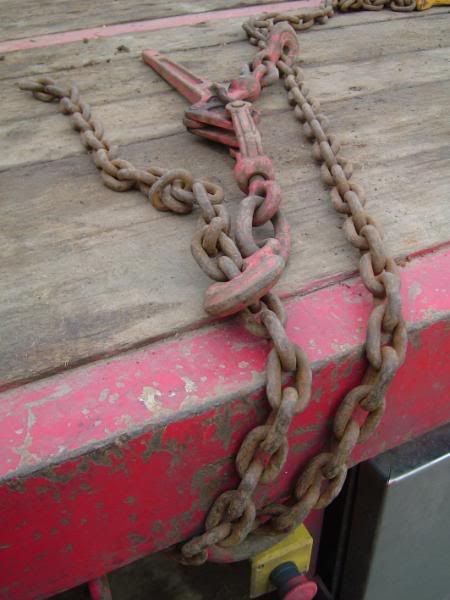
Securing Chains - Grab Hooks

The most commonly used chain for me. As the name implies the hook grabs back onto the chain itself, useful to shorten the chain around a D ring
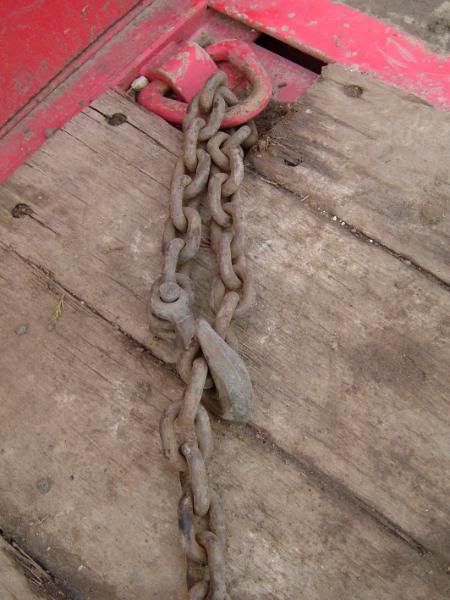
or to grab onto the side of the body which is how I usually use them.

Again used with a chain tensioner to pull tight.
Chain Tensioners.
A 3m long chain with a hook on either end is no good without something to pull the hooks towards each other and make it go tight, this is where the tensioners come in.
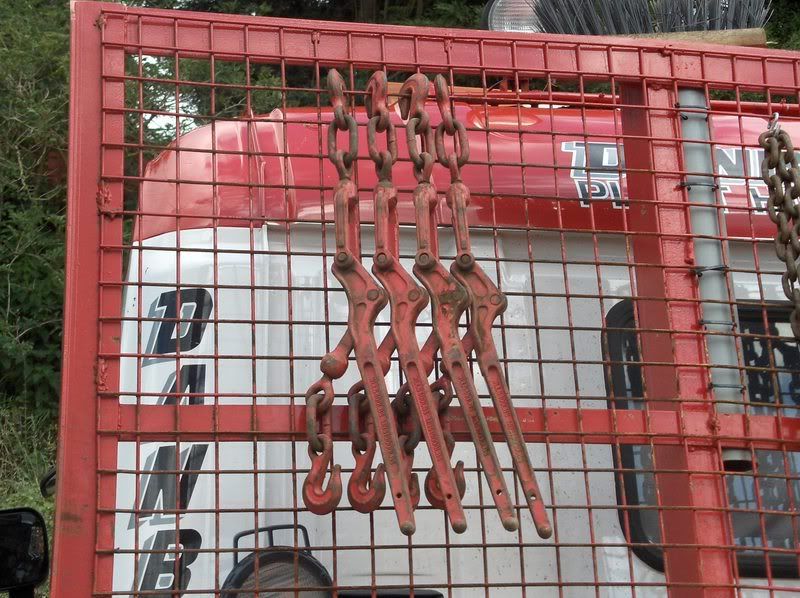
Dog Type.
These are not commonly used in the industry anymore, although I prefer the use of these to the ratchet ones. They are quicker to use and require essentially no maintence. To use these you attach the chain on one side and pass over the equipment to be secured and let the other hook hang loose. You pull the chain tight by hand and attach the top hook onto the chain like this.
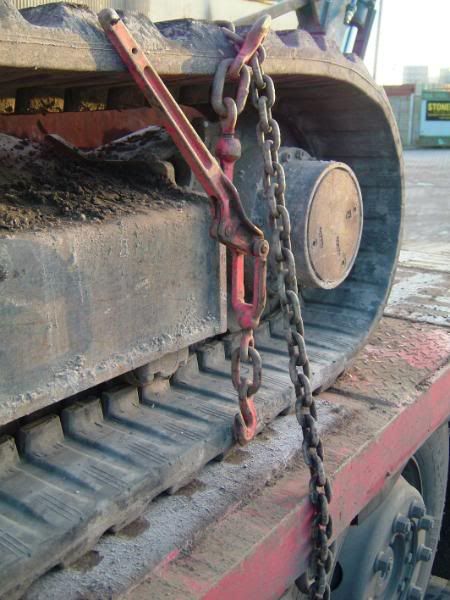
You then hook the free end of the chain onto the body and pull tight by hand, attach the bottom hook of the dog so that the chain is now semi taught and the dog bypasses the slack chain.
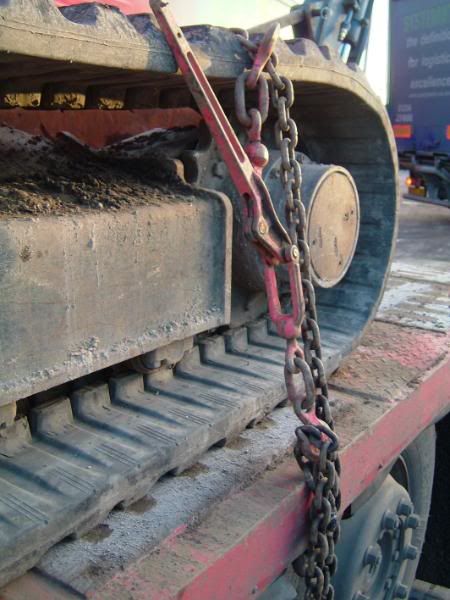
You then pull the handle down, being extremely careful to keep out of the way until it snaps shut. If you lose your grip or cannot close it, it may spring open with considerable force and cause injury if you are in the way. This is the reason for their lack of common use. A scaffold bar can be used for extra leverage to get them closed although bear in mind that it makes a bigger bar to dodge if it opens unexpentantly.

I usually wrap the slack chain around the handle so as to prevent any chance that it could inadvertantly spring open.
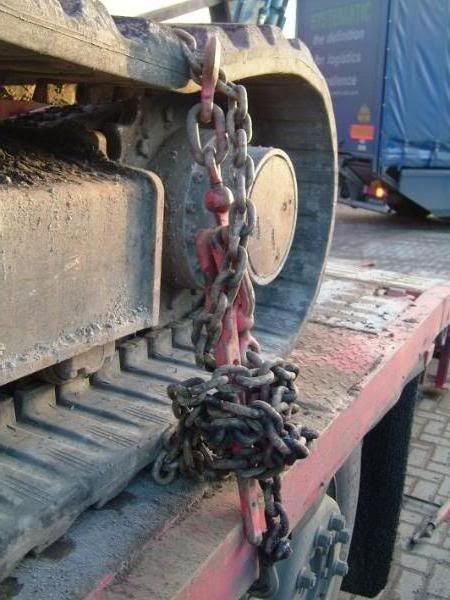
The above procedure can also be applied when passing the chain through a D loop.

Removal is carried out with care at arms length.
Ratchet Type.
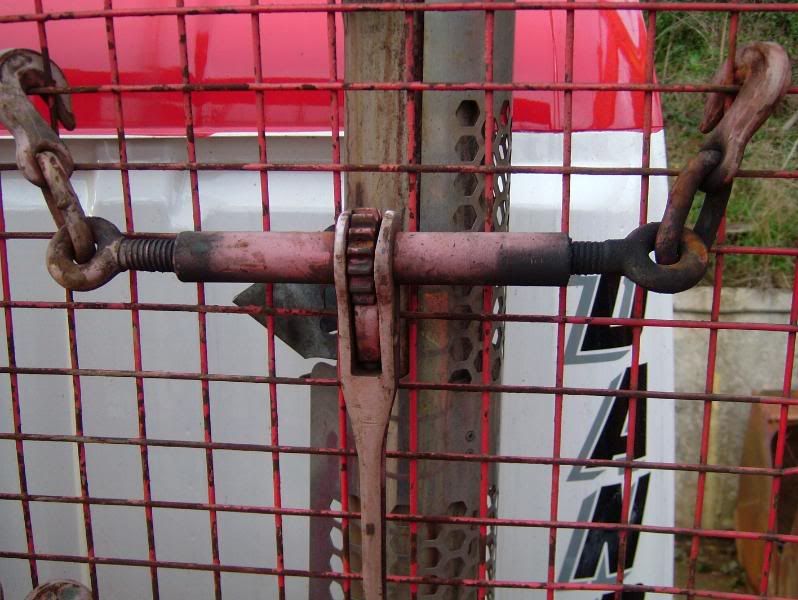
Basically this fulfills the same function as the dog, but is safer as it tightens up in a gradual process. You start with the hooks wound out and set the cam in the centre so it tightens the chain and clicks freely over the cog when you pass the handle the other way. It gradually pulls the hooks inwards, however if you haven't got the chain tight enough by hand or not started with the ratchets wound out enough you find them fully wound in and the chain still slack. You then have to unwind and start again. Removal is a simple matter of clickng the cam over and going the other way.
Ratchet Straps
Needless to say I also carry a fair few ratchet straps, and a few bits of rope.
Equipment.
There's a fair bit of kit involved in my job, a lot of it is common in other jobs but I'll describe it and it's uses.
Chains.
Probably the biggest range of kit that I carry, different chains for different jobs detailed below.
Drop Chain.

A simple short chain, generally used with a shackle through the lifting eye on a digger. Hook can be looped through sling eyes or bucket pin and back onto ring. Fitted with a large oval ring so can be used on a forklift, although this is not ideal.
Lifting Chains.

A set of 2, or pair of brothers. Also found in 4's but more usually associated with a crane or HIAB.

As per drop chain used with shackle or on forks, usually used for lifting several buckets or diesel tanks / drums. This set has sling hooks which are missing the safety clips.
Securing Chains - Sling Hooks

I carry a couple of these chains with large sling hooks on one end only for securing plant with smaller chain eyes. The hook is hooked onto the eye and the tail of the chain is run through a D ring and back towards the hook. A chain tensioner can then be used to pull it tight.

Securing Chains - Grab Hooks

The most commonly used chain for me. As the name implies the hook grabs back onto the chain itself, useful to shorten the chain around a D ring

or to grab onto the side of the body which is how I usually use them.

Again used with a chain tensioner to pull tight.
Chain Tensioners.
A 3m long chain with a hook on either end is no good without something to pull the hooks towards each other and make it go tight, this is where the tensioners come in.

Dog Type.
These are not commonly used in the industry anymore, although I prefer the use of these to the ratchet ones. They are quicker to use and require essentially no maintence. To use these you attach the chain on one side and pass over the equipment to be secured and let the other hook hang loose. You pull the chain tight by hand and attach the top hook onto the chain like this.

You then hook the free end of the chain onto the body and pull tight by hand, attach the bottom hook of the dog so that the chain is now semi taught and the dog bypasses the slack chain.

You then pull the handle down, being extremely careful to keep out of the way until it snaps shut. If you lose your grip or cannot close it, it may spring open with considerable force and cause injury if you are in the way. This is the reason for their lack of common use. A scaffold bar can be used for extra leverage to get them closed although bear in mind that it makes a bigger bar to dodge if it opens unexpentantly.

I usually wrap the slack chain around the handle so as to prevent any chance that it could inadvertantly spring open.

The above procedure can also be applied when passing the chain through a D loop.

Removal is carried out with care at arms length.
Ratchet Type.

Basically this fulfills the same function as the dog, but is safer as it tightens up in a gradual process. You start with the hooks wound out and set the cam in the centre so it tightens the chain and clicks freely over the cog when you pass the handle the other way. It gradually pulls the hooks inwards, however if you haven't got the chain tight enough by hand or not started with the ratchets wound out enough you find them fully wound in and the chain still slack. You then have to unwind and start again. Removal is a simple matter of clickng the cam over and going the other way.
Ratchet Straps
Needless to say I also carry a fair few ratchet straps, and a few bits of rope.
Labels:
chain tensioner,
grab hook,
load security,
ratchet strap,
sling hook
Subscribe to:
Posts (Atom)
